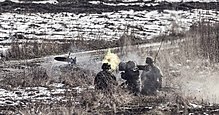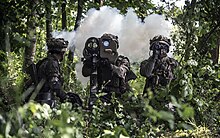This article has multiple issues. Please help improve it or discuss these issues on the talk page. (Learn how and when to remove these messages)
|
| RBS 56 BILL | |
|---|---|
 | |
| Type | SACLOS Anti-tank missile |
| Place of origin | Sweden |
| Service history | |
| In service | 1988 – present |
| Used by | See Operators |
| Production history | |
| Manufacturer | Bofors |
| Unit cost | $80,000 (1989) |
| Produced | 1985 – late 1990s |
| No. built | 15,000 + |
| Specifications | |
| Mass | 36 kg (launcher) |
| Length | 900 mm |
| Diameter | 150 mm |
| Muzzle velocity | 250 m/s |
| Effective firing range | 150 to 2,200 m |
| Guidance system | SACLOS |
The RBS 56 BILL is a Swedish manportable SACLOS wire-guided anti-tank missile developed by AB Bofors.
History
Development began in 1979 and BILL entered production in 1985. The Swedish Army began receiving the missile in March 1988. BILL stands for (Bofors, Infantry, Light and Lethal).
By 1996, 15,000 missiles had been produced and supplied to the Swedish and Austrian armies. Between 1996 and 1997, Brazil received a number of BILL missiles.
In the late 1990s, production shifted to the RBS 56B BILL 2. The Swedish army received the first deliveries of the BILL 2 in 1999.
Design

A man portable BILL system consists of a missile in a sealed launch tube, tripod, day sight and thermal night-vision sight. The missile's shaped charge warhead is aimed downwards at an angle of 30 degrees and is triggered by a proximity fuze as the missile passes over the intended target.
The top attack warhead allows the missile to strike the thinner top armour of tanks. To enable this to work effectively the missile flies 0.75 meters above the line of sight between the launcher and the target. A secondary effect of this is to enable the missile to be used to engage targets largely behind cover, for example a hull down tank.
When launched the missile is propelled from the launch tube at around 72 meters per second by a gas generator at the rear of the launch tube. Once the missile is clear of the launch tube the sustainer motor engages and accelerates the missile to a speed of 250 meters per second. Once the missile is about 400 meters from the launcher, the sustainer motor cuts out and the missile continues in free flight.
Operators
Current operators
 Ukraine: Ukrainian army
Ukraine: Ukrainian army Sweden: Swedish army, 1985–2013, 2021–
Sweden: Swedish army, 1985–2013, 2021–
- Re-acquired RBS 56 in 2021 in anticipation of the Swedish Armed Forces introducing a new, modern, medium-range anti-tank missile, with planned delivery from 2025.
Former operators
 Austria: through 2010, 3,000 purchased
Austria: through 2010, 3,000 purchased
- 1,000 RBS-56 Bill ordered in 1989, delivered in 1989-1993
- 2,000 RBS-56B Bill2 ordered 1996, delivered in 1998-2001
 Estonia: Purchased in 2006.
Estonia: Purchased in 2006. Latvia
Latvia Saudi Arabia
Saudi Arabia
References
- "Trade Registers". Archived from the original on 2019-04-22. Retrieved 2018-06-09.
- "RBS 56 BILL Anti-Tank Guided Missile". Military-Today.com. Archived from the original on 2022-08-28. Retrieved 2022-08-20.
- "Home and away wins for Bofors". International Defense Review. August 1989. p. 110.
- International Institute for Strategic Studies (2020). "Chapter Eight: Latin America and the Caribbean". The Military Balance. 120 (1): 405. doi:10.1080/04597222.2020.1707970. S2CID 219623398.
- ^ "Trade Registers". armstrade.sipri.org. Retrieved 2023-06-06.
- "Ukrainian military received Swedish RBS-56 ATGMs".
- International Institute for Strategic Studies (2015). "Chapter Four: Europe". The Military Balance. 115 (1): 140. doi:10.1080/04597222.2015.996348. S2CID 219628714.
- "Förmågan att bekämpa pansarfordon stärks". Swedish Armed Forces. 16 December 2021. Retrieved 1 January 2025.
- International Institute for Strategic Studies (2010). "Chapter Three: Europe". The Military Balance. 110 (1): 175. doi:10.1080/04597220903545825. S2CID 219623422.
- International Institute for Strategic Studies (2006). "Europe". The Military Balance. 106 (1): 68. doi:10.1080/04597220600782820. S2CID 219626337.
- "Watch: A Solid Catastrophic, K-Kill - Sweden's SACLOS ATGM". 15 May 2016.
- Jane's Infantry Weapons 2005-2006.
This article relating to missiles is a stub. You can help Misplaced Pages by expanding it. |